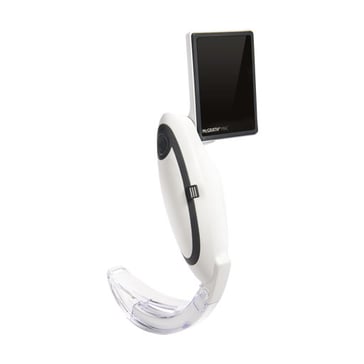First things first: I have ZERO, ZIP, NADA relationship with McGrath.
I have been doing anesthesia for 30 years. Over the years I have seen all kinds of airways. To rip off Clint Eastwood: the Good, the Bad, and the Ugly. I always considered myself a very good laryngoscopist, who could intubate just about everything. I have intubated burn patients and massive facial trauma patients at Shock Trauma in Baltimore and in numerous ERs where the ER docs had paralyzed a patient that they subsequently couldn’t intubate.
First of all, what exactly is a McGrath? A McGrath is a video laryngoscope. Its basic shape is similar to a Mac blade on a short laryngoscope handle. It comes in numerous blade sizes (2,3,4) just like a regular Mac laryngoscope. At its tip, is a light source with a tiny fiberoptic camera that is attached to a small video screen that is at the butt end of the handle. The disposable plastic blades slide over the permanently attached bladed that houses the fiberoptics.

What makes a McGrath superior to a standard laryngoscope? For those of you who aren’t intubating patients every day, or ever, here’s a great analogy: A McGrath quite literally allows you to see around corners. In a routine intubation with a standard laryngoscope, the anesthesiologist or CRNA lifts a patient’s head slightly and tilts it slightly backwards. This maneuver, called putting the patient in the “sniffing position” aligns the axis of the mouth, pharynx and larynx, thus making it possible to see the vocal cords. A standard laryngoscopy with a standard laryngoscope requires direct vision of the vocal cords. Most “tough” intubations occur when something in the patient’s anatomy interferes with that direct line of sight, such as a very anterior larynx, a small mouth, protruding teeth or tongue and soft tissue surrounding the larynx.
In contrast, a McGrath doesn’t require a direct line of sight because the “seeing” is done by the camera at the tip of the blade, and that view is then displayed on the video screen. No direct line of sight needed!! Once the cords are visible, a standard endotracheal tube with a standard stylet is inserted under direct video vision. If the cords are still anterior after standard positioning maneuvers to improve the view, a Bougie of Eschmann stylet with a good bend in the end can be passed through the cords first, and then an endotracheal slid down over the Eschmann/Bougie. In addition, the light source for a McGrath provides a very bright light at the tip of the blade, making visualization of the larynx MUCH easier.
Bottom line: With a McGrath, if you can see it, you can intubate it. Although in most institutions, including my own, McGraths are still somewhat reserved for anticipated difficult intubations, my question is “Why?” When a clearly superior technology exists, USE IT 100% OF THE TIME!!!!
About the Author: Stephen Punzak, MD is a practicing Anesthesiologist as well as the CEO of One Medical Passport. He founded One Medical Passport because he has always had a vision of how healthcare could run more efficiently using technology. He frequently writes on medical topics, workflow efficient measures and ASC industry trends.




